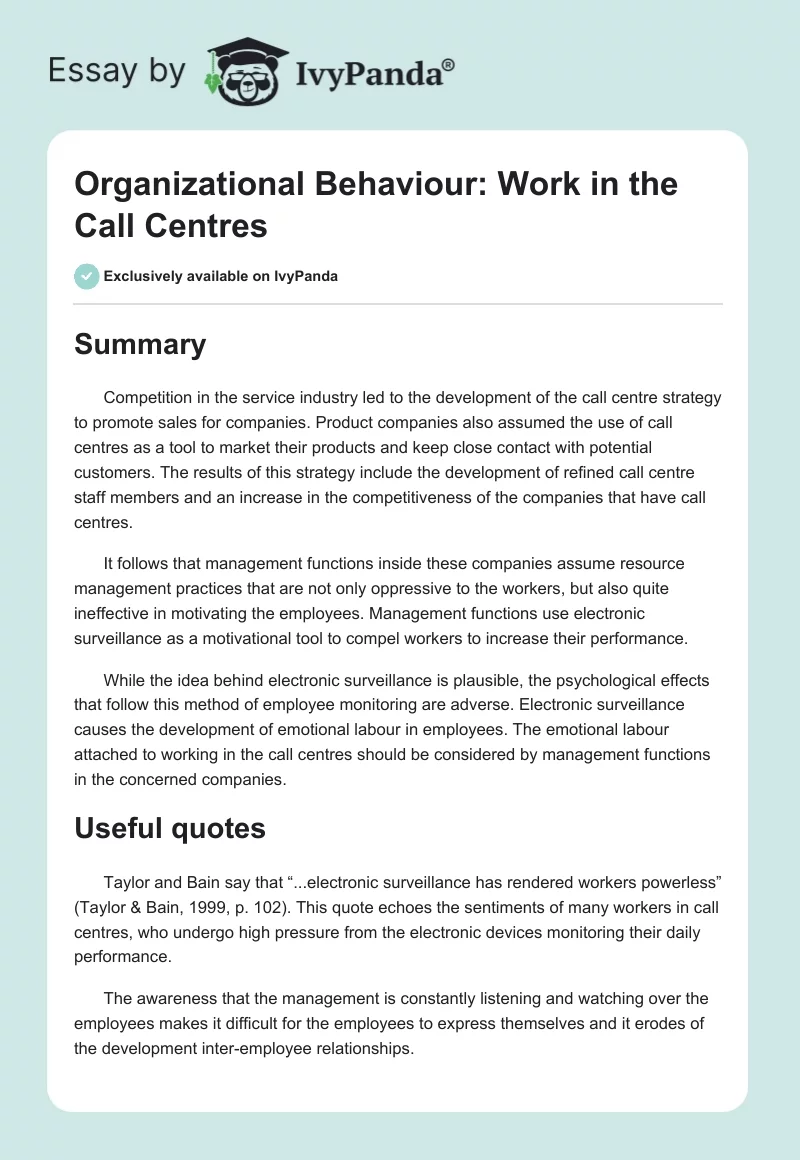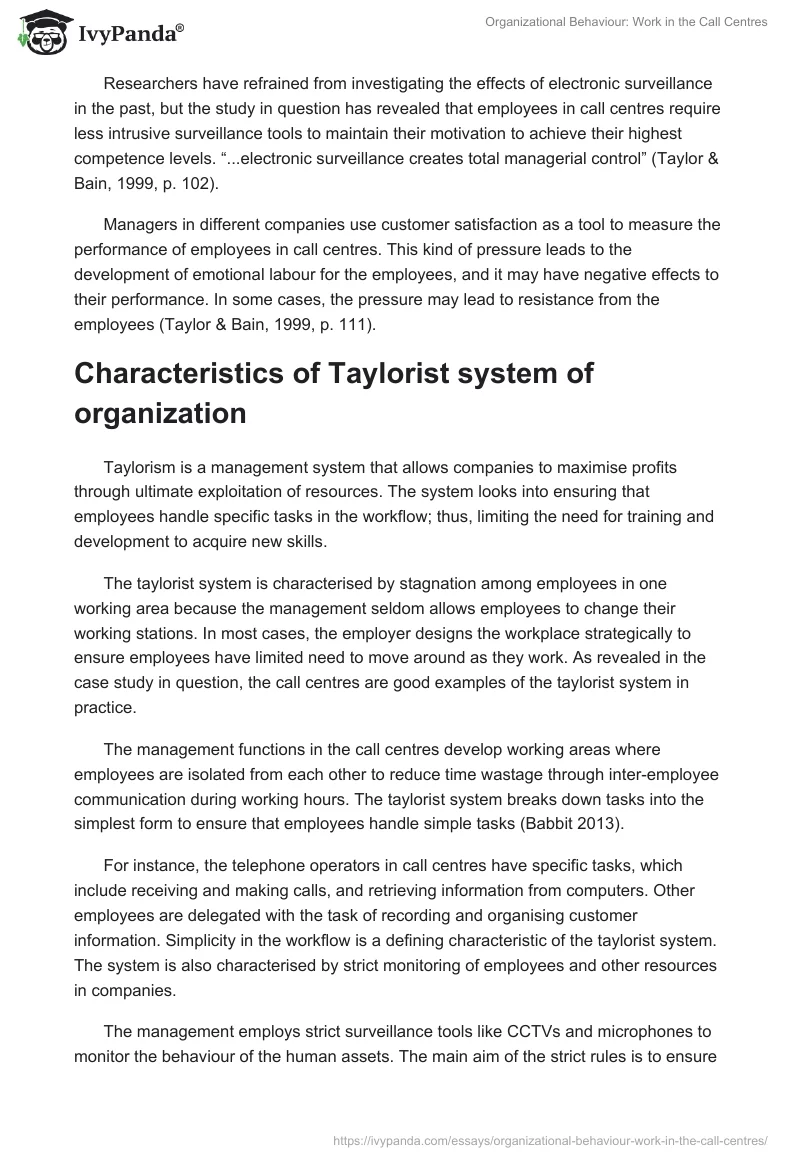Summary
Competition in the service industry led to the development of the call centre strategy to promote sales for companies. Product companies also assumed the use of call centres as a tool to market their products and keep close contact with potential customers. The results of this strategy include the development of refined call centre staff members and an increase in the competitiveness of the companies that have call centres.
It follows that management functions inside these companies assume resource management practices that are not only oppressive to the workers, but also quite ineffective in motivating the employees. Management functions use electronic surveillance as a motivational tool to compel workers to increase their performance.
While the idea behind electronic surveillance is plausible, the psychological effects that follow this method of employee monitoring are adverse. Electronic surveillance causes the development of emotional labour in employees. The emotional labour attached to working in the call centres should be considered by management functions in the concerned companies.
Useful quotes
Taylor and Bain say that “…electronic surveillance has rendered workers powerless” (Taylor & Bain, 1999, p. 102). This quote echoes the sentiments of many workers in call centres, who undergo high pressure from the electronic devices monitoring their daily performance.
The awareness that the management is constantly listening and watching over the employees makes it difficult for the employees to express themselves and it erodes of the development inter-employee relationships.
Researchers have refrained from investigating the effects of electronic surveillance in the past, but the study in question has revealed that employees in call centres require less intrusive surveillance tools to maintain their motivation to achieve their highest competence levels. “…electronic surveillance creates total managerial control” (Taylor & Bain, 1999, p. 102).
Managers in different companies use customer satisfaction as a tool to measure the performance of employees in call centres. This kind of pressure leads to the development of emotional labour for the employees, and it may have negative effects to their performance. In some cases, the pressure may lead to resistance from the employees (Taylor & Bain, 1999, p. 111).
Characteristics of Taylorist system of organization
Taylorism is a management system that allows companies to maximise profits through ultimate exploitation of resources. The system looks into ensuring that employees handle specific tasks in the workflow; thus, limiting the need for training and development to acquire new skills.
The taylorist system is characterised by stagnation among employees in one working area because the management seldom allows employees to change their working stations. In most cases, the employer designs the workplace strategically to ensure employees have limited need to move around as they work. As revealed in the case study in question, the call centres are good examples of the taylorist system in practice.
The management functions in the call centres develop working areas where employees are isolated from each other to reduce time wastage through inter-employee communication during working hours. The taylorist system breaks down tasks into the simplest form to ensure that employees handle simple tasks (Babbit 2013).
For instance, the telephone operators in call centres have specific tasks, which include receiving and making calls, and retrieving information from computers. Other employees are delegated with the task of recording and organising customer information. Simplicity in the workflow is a defining characteristic of the taylorist system. The system is also characterised by strict monitoring of employees and other resources in companies.
The management employs strict surveillance tools like CCTVs and microphones to monitor the behaviour of the human assets. The main aim of the strict rules is to ensure the human resources always offer their highest competence levels. The taylorist system focuses on increasing the outputs from business processes with minimal consideration of employee satisfaction at work.
Strengths of the system
The taylorist system results to higher outputs for a company. The essence of doing business is to increase profits; hence, the system is one of the most viable management models. It influences the effective management of both the material and human resources in a company.
The system also eliminates the need for human resource management functions to develop training and development programs for employees because their tasks are clearly communicated and quite simply defined. Promotion opportunities are limited in the system; hence, most employees attain high levels of skills in handling their tasks (Scientific Management 2014).
The system gives the management the power to control employees, although it may lead to high rates of turnover among the human resources.
The system also simplifies work, meaning that in case an employee quits his job it would be easy to replace him or her with a new employee because they only need training in specific areas. The system develops a competent workforce with high levels of performance because they are forced to portray their best skills.
Consequences of the system for workers
The taylorist system leads to the development of pressure on the employees. The Taylorist system uses the concept of worker soldiering, which involves monitoring employees’ time and performance. This method of surveillance exerts psychological pressure on human assets (Backer 1998). The employees are forced to deliver higher outputs, and the strict surveillance methods used may lead to emotional labour.
For instance, in the call centres, electronic surveillance causes emotional labour for the employees because not only do they have to hide their feelings from the customers on the telephone, but they also have to hide their feelings from the employers (Taylor & Bain, 1999, p. 107). The management demands that they should always be busy on the phone; hence, they have no time to engage in any social activities or rest while at work.
The isolation designs in the system also lead to the development of task forces with limited interpersonal relationships. This lack of inter-employee relationships could lead to low cohesion between the employees when handling projects in teams. The taylorist system looks to motivate employees to work hard in their stations, but it may result to the erosion of motivation among the employees.
When the management function becomes too harsh in handling the employees, they may resist the rules individually or in groups. The system also leads to many divisions of work to increase effectiveness in managing different tasks. Employees may get frustrated with the system because it does not open opportunities for promotions and personal career development.
The management treats the employees as machines rather than human assets; thus, it may lead to high turnover rates. The taylorist system should be applied with caution in companies because it can lead to the opposite of its expected results. Employee motivation and monitoring should be integrated carefully for the realization of positive effects in their performance.
List of References
Babbit, T. 2013, Revisiting Taylorism at the Watertown Arsenal. Web.
Backer, P. R. 1998, Scientific Management. Web.
Scientific Management (Taylorism) 2014. Web.
Taylor, P. & Bain, P. 1999, ‘‘An assembly line in the head’: work and employee relations in the call centre’, Industrial Relations Journal, vol. 30, no. 2, pp. 101-117.


